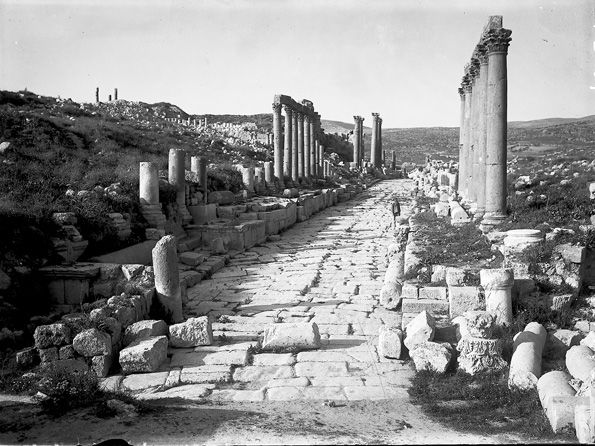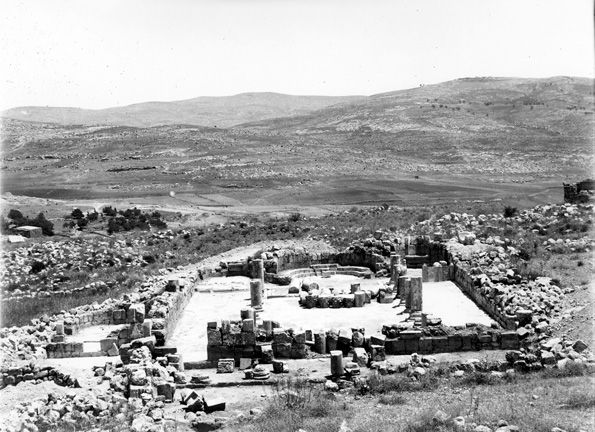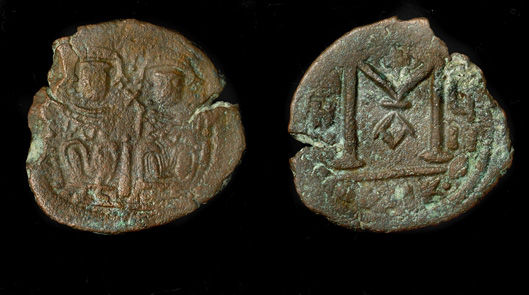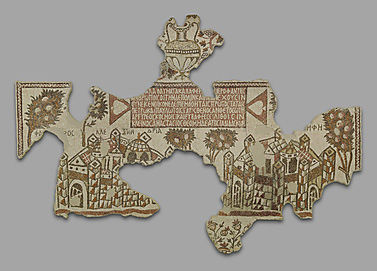View of Via Antoninianus from the South Tetrapylon, Gerasa (Jerash), Jordan. Yale University Art Gallery, Gerasa Collection
One of the mosaics on view in the exhibition comes from the city of Gerasa (present-day Jerash, Jordan). Gerasa was an architecturally dense city founded during the second century B.C. Under Roman rule it included two theaters, two bath houses, a nymphaeum (public fountain), and a macellum (meat market).1 Although its prosperity diminished over time, by the third century A.D. the city had regained some of its wealth and reinstituted massive building campaigns. The original Roman temples, which had stopped being used, were not demolished. Thus new buildings, many of them Christian churches,2 added to the already architecturally dense fabric of the city, reducing the once large, straight streets to smaller byways.
Church of Saints Peter and Paul, Gerasa (Jerash), Jordan, in 1931. Yale University Art Gallery, Gerasa Collection
The source of Gerasa's wealth is not certain.3 Nevertheless, several objects from Gerasa, which are on view in the exhibition, indicate that commerce was certainly a major contributor to the city's prosperity. Examples include the seventh-century copper coins (shown below) and several oil lamps, whose dates suggest that Gerasa was still inhabited during the Umayyad period (from the seventh to the eighth centuries), even though it was once thought to have been deserted at that time.
Greek Fals of Gerasa, ca. 660–680. Copper. Byzantine Collection, Dumbarton Oaks, Washington, D.C. (BZC.2000.4.34)
Unlike other major cities in the region, such as Palmyra and Petra, Gerasa always retained a late-Hellenistic and Roman character underneath its multidimensional fabric.4 A synagogue built in 530–531, the occupation of the Persians in 614, and the rule under the Muslims after 635 all speak to a multicultural and vibrant cityscape—much like the one represented in the mosaic on view.
Floor Mosaic Depicting the Cities of Memphis and Alexandria, ca. 540. Yale University Art Gallery, New Haven, Excavated by the Yale–British School Archaeological Expedition, 1928–29 (1932.1735). Photograph courtesy of Christopher Gardner
Originally created for the floor of the Church of Saints Peter and Paul, this mosaic is a testament to the strong and vibrant presence of Christian communities in Gerasa during antiquity. Its dedicatory inscription points to the authority of the bishop Anastasios, and its representation of the cities of Memphis and Alexandria, in Egypt, suggests the Church's oversight of even the most powerful of cities of the day. As the inscription emphasizes, it is Anastasios, not the cities, that provide "beautiful marvels to the people who inhabit this city and land."5
[1] Hugh N. Kennedy, "Gerasa and Scythopolis: Power and Patronage in the Byzantine Cities of Bilād Al-Sham," The Byzantine and Early Islamic Near East (Aldershot, Hampshire: Ashgate Publishing Limited, 2006), 200.



